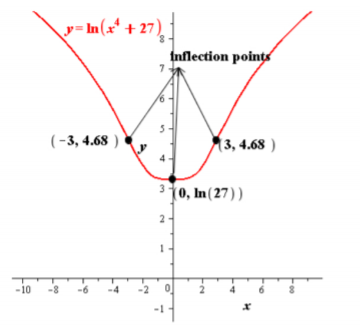
Concept explainers
(a)
To find:The intervals of increase or decrease.
(a)
Explanation of Solution
Given: f(x)=ln(x4+27)
Calculate the first derivative of the given function.
f′(x)=4x3x4+27
Equate to zero.
0=4x3x4+27x=0
The function is decreasing in the interval (−∞, 0) .
The function is increasing in the interval (0, ∞)
(b)
To find :The
(b)
Explanation of Solution
The function is decreasing in the interval (−∞, 0) .
The function is increasing in the interval (0, ∞)
The value of f′ is changing from negative to positive at x=0
So, the local
There is no local
(c)
To find :The concavity of the function and the point of inflection.
(c)
Explanation of Solution
Calculate the second derivative of the given function.
f″(x)=324x2−4x6(x4+27)2=4x2(x4−81)(x4+27)24x2=0x=0
f″(x)<0 for the interval −∞<x<−3 . So, the graph is concave down for (−∞, −3)
f″(x)>0 for the interval −3<x<0 . So, the graph is concave up for (−3, 0)
f″(x)>0 for the interval 0<x<3 . So, the graph is concave up for (0, 3)
f″(x)<0 for the interval 3<x<∞ . So, the graph is concave down for (3, ∞)
The inflection points are (−3. 4.68), (0, 3.30) and (3, 4.68)
(d)
To sketch :The graph of result obtained from part (a) to (c).
(d)
Explanation of Solution
Given: f(x)=ln(x4+27)
The graph of the result obtained is shown in figure below.

Figure (1)
Therefore, the required graph is shown in figure (1).
Chapter 4 Solutions
Single Variable Calculus: Concepts and Contexts, Enhanced Edition
- please do Q3arrow_forwardUse the properties of logarithms, given that In(2) = 0.6931 and In(3) = 1.0986, to approximate the logarithm. Use a calculator to confirm your approximations. (Round your answers to four decimal places.) (a) In(0.75) (b) In(24) (c) In(18) 1 (d) In ≈ 2 72arrow_forwardFind the indefinite integral. (Remember the constant of integration.) √tan(8x) tan(8x) sec²(8x) dxarrow_forward
- Find the indefinite integral by making a change of variables. (Remember the constant of integration.) √(x+4) 4)√6-x dxarrow_forwarda -> f(x) = f(x) = [x] show that whether f is continuous function or not(by using theorem) Muslim_mathsarrow_forwardUse Green's Theorem to evaluate F. dr, where F = (√+4y, 2x + √√) and C consists of the arc of the curve y = 4x - x² from (0,0) to (4,0) and the line segment from (4,0) to (0,0).arrow_forward
- Evaluate F. dr where F(x, y, z) = (2yz cos(xyz), 2xzcos(xyz), 2xy cos(xyz)) and C is the line π 1 1 segment starting at the point (8, ' and ending at the point (3, 2 3'6arrow_forwardCan you help me find the result of an integral + a 炉[メをメ +炉なarrow_forward2 a Can you help me find the result of an integral a 아 x² dxarrow_forward
 Calculus: Early TranscendentalsCalculusISBN:9781285741550Author:James StewartPublisher:Cengage Learning
Calculus: Early TranscendentalsCalculusISBN:9781285741550Author:James StewartPublisher:Cengage Learning Thomas' Calculus (14th Edition)CalculusISBN:9780134438986Author:Joel R. Hass, Christopher E. Heil, Maurice D. WeirPublisher:PEARSON
Thomas' Calculus (14th Edition)CalculusISBN:9780134438986Author:Joel R. Hass, Christopher E. Heil, Maurice D. WeirPublisher:PEARSON Calculus: Early Transcendentals (3rd Edition)CalculusISBN:9780134763644Author:William L. Briggs, Lyle Cochran, Bernard Gillett, Eric SchulzPublisher:PEARSON
Calculus: Early Transcendentals (3rd Edition)CalculusISBN:9780134763644Author:William L. Briggs, Lyle Cochran, Bernard Gillett, Eric SchulzPublisher:PEARSON Calculus: Early TranscendentalsCalculusISBN:9781319050740Author:Jon Rogawski, Colin Adams, Robert FranzosaPublisher:W. H. Freeman
Calculus: Early TranscendentalsCalculusISBN:9781319050740Author:Jon Rogawski, Colin Adams, Robert FranzosaPublisher:W. H. Freeman
 Calculus: Early Transcendental FunctionsCalculusISBN:9781337552516Author:Ron Larson, Bruce H. EdwardsPublisher:Cengage Learning
Calculus: Early Transcendental FunctionsCalculusISBN:9781337552516Author:Ron Larson, Bruce H. EdwardsPublisher:Cengage Learning





